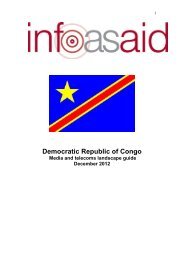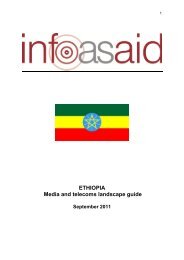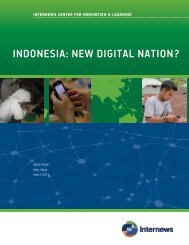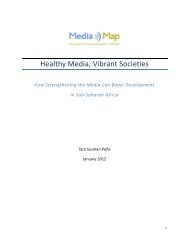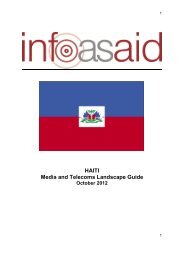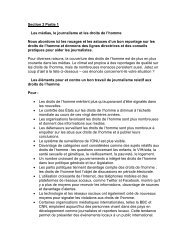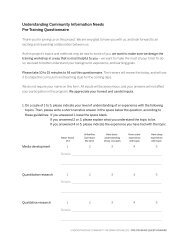STArTInG A LOCAL RADiO stAtiOn - Nai
STArTInG A LOCAL RADiO stAtiOn - Nai
STArTInG A LOCAL RADiO stAtiOn - Nai
- No tags were found...
You also want an ePaper? Increase the reach of your titles
YUMPU automatically turns print PDFs into web optimized ePapers that Google loves.
Section 5: Creating Powerful ProgramsKeep the focus of your program clear for your audience.If you are motivated to prompt a change in attitude or raise awareness on an issue, think about what youwant to achieve through your program. It’s helpful to provide your listeners with relevant information.Access to accurate information and more knowledge about a subject or situation can lead listeners toadopt new attitudes and make behavioral shifts.It’s helpful to think about behavioral change in three steps:1. Knowledge is the information that listeners keep and can use after listening to the program.2. Attitude is what listeners think and/or feel after acquiring knowledge about a subject.3. Behavior is where we measure change that may occur because of new knowledge and attitudes. 2Below is an example from a Salam Watandar program that focused on encouraging more women to runfor office during a recent provincial election.Raising Awareness of Afghan Women in GovernmentAlarmed by a May 1, 2009 report that not a single female candidate had registered for Afghanistan’sprovincial council elections in eight provinces, Salam Watandar quickly produced a numberof stories, interviews, and an outreach campaign to highlight the issue.One week later, a total of 342 women had registered for 124 seats on provincial councils aroundthe country.“We feel the media play an extremely important role in Afghanistan’s democratic transition,”said Masood Farivar, the manager of Salam Watandar. “Afghanistan has made great strides in thepast eight years towards equal representation of women in politics, but the growing insurgencythreatens to undermine their status. Elections are about the future leadership and direction ofthe country, and we felt it was important to encourage women to take part in that process.”Source: Internews website www.internews.orgTarget AudienceA radio producer must decide what the target audience will be. A target audience is the group of peoplethat you want to attract as listeners to a program. It’s usually people who share similar beliefs and values,face similar challenges and struggles and/or live and work in similar environments.When designing a program for a target audience, a producer will need to consider:nnnnWho are the people we want to listen to this program?Why do we want them to listen to this program?What matters to them?How do they speak?2Michael Shipler. “Youth Radio for Peacebuilding: a guide.” Search for Common Ground. Belgium, 2006.52 STARTING A <strong>LOCAL</strong> RADIO STATION: A MANUAL FOR AFGHANISTAN



